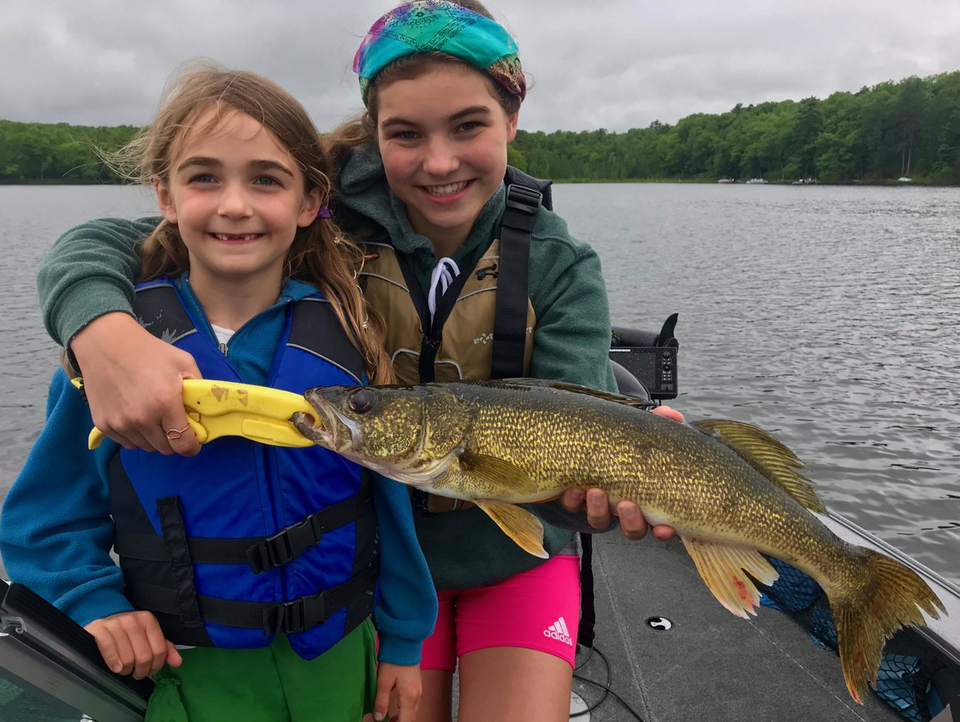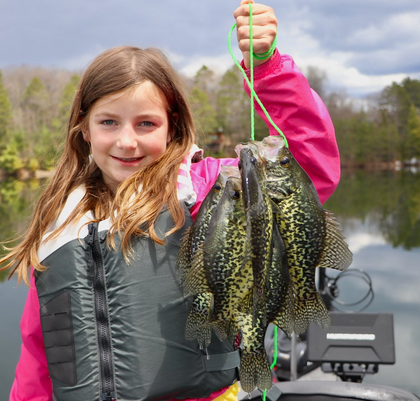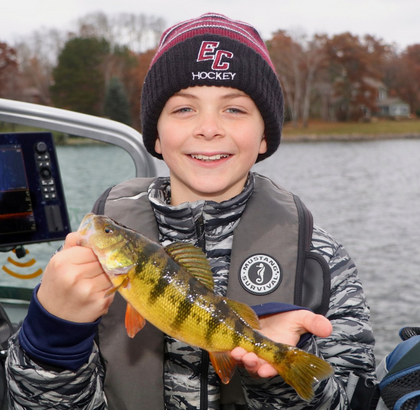Top Five Tips for Fishing with Kids
Top Five Tips for Fishing with Kids
Dr. Jason Halfen
The Technological Angler
We need to take more kids fishing. Those of us who have been fishing since our youth recognize the joy and fulfillment that accompanies time on the water. Organized fishing leagues and teams at the high school and college level are helping to bolster participation by teenagers and young adults, but the youngest anglers need individualized introductions to our favorite pastime.
Whether you recognize it or not, participation in fishing is in decline in the United States. In 2018, the Recreational Boating and Fishing Foundation reported that 16.1% of the population aged 6 years or older had gone fishing at least once during the prior calendar year. That sounds like a lot of people, but it’s a percentage that has been in a slow, steady decline for the better part of a decade. More than 80% of current adult anglers report that their fishing experiences began as a child; if we want people to enjoy fishing as they age, and to care about fish, fishing, and the outdoors as adults, we need to start them young.
Whether you are a parent, an aunt or uncle, a grandparent, or just a close friend of a child who wants to fish, you – as someone who wants to contribute to the development of a young angler – are qualified to take a kid fishing. As a father of four, I have spent the past 15 years fishing with my kids – sometimes one at a time, but more often with a subset of the clan. During that time, I’ve learned to navigate the rough waters that can sometimes be encountered when first-time, or generally inexperienced, young anglers are in the boat or next to me on the shore. Here are five tips that will help to make your trips with future avid anglers more successful and enjoyable, both for kids and for their grown-ups.
Whether you recognize it or not, participation in fishing is in decline in the United States. In 2018, the Recreational Boating and Fishing Foundation reported that 16.1% of the population aged 6 years or older had gone fishing at least once during the prior calendar year. That sounds like a lot of people, but it’s a percentage that has been in a slow, steady decline for the better part of a decade. More than 80% of current adult anglers report that their fishing experiences began as a child; if we want people to enjoy fishing as they age, and to care about fish, fishing, and the outdoors as adults, we need to start them young.
Whether you are a parent, an aunt or uncle, a grandparent, or just a close friend of a child who wants to fish, you – as someone who wants to contribute to the development of a young angler – are qualified to take a kid fishing. As a father of four, I have spent the past 15 years fishing with my kids – sometimes one at a time, but more often with a subset of the clan. During that time, I’ve learned to navigate the rough waters that can sometimes be encountered when first-time, or generally inexperienced, young anglers are in the boat or next to me on the shore. Here are five tips that will help to make your trips with future avid anglers more successful and enjoyable, both for kids and for their grown-ups.
Safety first
Safety on and near the water is paramount for all ages, but especially for kids. I take a three-pronged approach to providing safe fishing experiences for my young anglers, and consider (1) water safety, (2) equipment safety, and (3) fish safety.
Water safety means that everyone in the boat, not just my young guests, wears a USCG-approved life jacket – all the time – no matter how well anyone thinks they can swim. Water safety also means sun protection. The Skin Cancer Foundation reports that having five or more sunburns as a child increases that person’s risk of melanoma by 80%. Hats, sunglasses, and lightweight technical apparel should provide most of your coverage, with a healthy dose of a mineral-based sunscreen on any exposed skin.
Safety on and near the water is paramount for all ages, but especially for kids. I take a three-pronged approach to providing safe fishing experiences for my young anglers, and consider (1) water safety, (2) equipment safety, and (3) fish safety.
Water safety means that everyone in the boat, not just my young guests, wears a USCG-approved life jacket – all the time – no matter how well anyone thinks they can swim. Water safety also means sun protection. The Skin Cancer Foundation reports that having five or more sunburns as a child increases that person’s risk of melanoma by 80%. Hats, sunglasses, and lightweight technical apparel should provide most of your coverage, with a healthy dose of a mineral-based sunscreen on any exposed skin.
Equipment safety is largely related to hooks and weights. Obviously, we want to teach kids the importance of hook safety – how they should handle hooks properly, with or without a fish attached. Instruct them also on the proper use of lead weights. Don’t bite down on that split shot to crimp it onto your line; it, like most fishing weights, is made of lead, a toxic metal that especially hazardous when ingested - even in microscopic quantities.
Prepare ahead of time
When kids arrive to fish, either from the boat or the shore, be ready to get started, right away. That means tying up their rigs in advance so that, once the boat is positioned or a suitable shoreline spot is selected, you can work with them to get a line in the water. One of the things I like to do is work on casting in the backyard, especially for first-timers, or those graduating to more rod/reel options. Those little rubber plugs that you can find at any sporting goods retailer make this an easy and safe proposition.
Bites, and lots of them
A young angler’s fish experiences on the water should focus on bites that provide LOTS of action. Kids want to see that bobber go down quickly, and often, so think hard about which fish you plan to target. Panfish are an obvious choice, especially in spring and early summer when large numbers of bluegills and crappies are easy to find and willing to bite. That midsummer topwater bass bite you love so much may be better suited to a more advanced youth angler who can appreciate the excitement of a visual strike and learn to not set the hook right away.
A young angler’s fish experiences on the water should focus on bites that provide LOTS of action. Kids want to see that bobber go down quickly, and often, so think hard about which fish you plan to target. Panfish are an obvious choice, especially in spring and early summer when large numbers of bluegills and crappies are easy to find and willing to bite. That midsummer topwater bass bite you love so much may be better suited to a more advanced youth angler who can appreciate the excitement of a visual strike and learn to not set the hook right away.
Fishing-related distractions
No matter how well prepared we are, there will invariably be times that the action slows. This is NOT the time to pull out your phone, or let your young anglers reach for their favorite gizmo. Instead, have some fishing-related distractions at the ready. My youngest guests (and plenty of older ones too) love exploring the underwater world with my Aqua-Vu underwater camera system. In fact, I’m convinced that kids like seeing fish and the places they live almost as much as they like catching them. A life-long fishing skill that can be introduced when the bite gets slow is knot tying. Younger kids can start by learning to tie a Palomar knot and an Improved Clinch Knot; older kids can also learn to tie a line-to-line knot like the Double Uni knot. You’ll be surprised how quickly they learn, and how satisfied they are when they begin tying up their own rigs.
No matter how well prepared we are, there will invariably be times that the action slows. This is NOT the time to pull out your phone, or let your young anglers reach for their favorite gizmo. Instead, have some fishing-related distractions at the ready. My youngest guests (and plenty of older ones too) love exploring the underwater world with my Aqua-Vu underwater camera system. In fact, I’m convinced that kids like seeing fish and the places they live almost as much as they like catching them. A life-long fishing skill that can be introduced when the bite gets slow is knot tying. Younger kids can start by learning to tie a Palomar knot and an Improved Clinch Knot; older kids can also learn to tie a line-to-line knot like the Double Uni knot. You’ll be surprised how quickly they learn, and how satisfied they are when they begin tying up their own rigs.
Don’t forget that they’re kids
A kid in a fishing cap carrying a spincast rod and reel combo does not have the same expectations, or capacity for adversity, as a seasoned tournament pro. Kids get hungry and thirsty, so have healthy snacks and cold water in the cooler. Kids have to go the bathroom, so figure out how you’re going to manage that. Kids get uncomfortable when it’s too hot, or too cold, or rainy (or snowy), so dress them appropriately, be ready to call it quits if the weather turns sour, or simply defer your trip until the weather becomes a non-factor. And finally, my rule of thumb is that when my kid is ready to call it a day – that’s when we stop, no matter how good the bite is, or how much fun we (as adults) are having. Those fishing-related distractions can sometimes serve as a bridge from one productive and fun fishing period to another, but if I look into my kids’ eyes and see that they’re done, then it’s time to tidy up and head to the ramp.
We need to take more kids fishing. It’s good for our sport, it’s good for us, but above all, it’s good for them. Do your part by getting on a good bite and taking a kid fishing – today!
A kid in a fishing cap carrying a spincast rod and reel combo does not have the same expectations, or capacity for adversity, as a seasoned tournament pro. Kids get hungry and thirsty, so have healthy snacks and cold water in the cooler. Kids have to go the bathroom, so figure out how you’re going to manage that. Kids get uncomfortable when it’s too hot, or too cold, or rainy (or snowy), so dress them appropriately, be ready to call it quits if the weather turns sour, or simply defer your trip until the weather becomes a non-factor. And finally, my rule of thumb is that when my kid is ready to call it a day – that’s when we stop, no matter how good the bite is, or how much fun we (as adults) are having. Those fishing-related distractions can sometimes serve as a bridge from one productive and fun fishing period to another, but if I look into my kids’ eyes and see that they’re done, then it’s time to tidy up and head to the ramp.
We need to take more kids fishing. It’s good for our sport, it’s good for us, but above all, it’s good for them. Do your part by getting on a good bite and taking a kid fishing – today!


